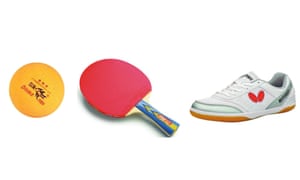I was introduced to table tennis quite young. My dad was a county league player back in the day in Omagh, Northern Ireland, and we had a car port which we filled with a table tennis table instead of a car. I’d play with my siblings and I kept it up through university, but then just stopped. It was only in the last couple of years that I picked up a bat again. I suddenly remembered just how much I enjoyed playing.
I joined Brighton Table Tennis Club last year after seeing a notice for a 50+ group, and started going regularly. Then in September last year, I was having a shower when I found a lump. Lab tests revealed I had grade three breast cancer. I stopped playing when I had my surgery, but two weeks later I was back at the club, hitting table tennis balls. Being physically active is part of cancer treatment, and it’s a way to feel empowered about the diagnosis. All the other stuff (the surgery, the chemo, the radiotherapy) is done to you. But table tennis is something I can do for myself.
The chemo affects my energy levels, but that’s what’s great about table tennis: on a good day when you’re feeling well, you can play at a high standard, but even on a bad day, you can still play.
Table tennis can be a pretty serious workout if you want it to be – I’ll often come away with my T-shirt wringing with sweat. But what I love most is the inclusiveness of the club. We’ve got elite juniors, 50+ sessions, disability sessions, and sessions for refugees (and we’ve recently started Ricochet +, for people living with cancer). I’ll be playing opposite lads from Afghanistan or Eritrea whose English may not be very good, but it doesn’t matter – there is a connection there.
My weekend workout
How often do you play? Three or four times a week.
Go-to post-game meal? Poached eggs, avocado and chilli on toast from Egg & Spoon round the corner from the club.
Favourite shot? If the ball sits up in the right place, everybody loves a forehand drive.
Five ways to get started
1 If you’re a total beginner or have poor hand-eye coordination, going straight into a game might not be helpful. Start by developing your bat skills: bouncing the ball on the floor or up in the air.
2 The best way to hold your bat is with a “handshake grip”. Imagine you’re shaking hands with the bottom end of the bat, and rest your index finger along the edge of the handle without touching the rubber.
3 A common mistake is to hit with the bat face at an open angle, so the ball goes too high. To keep the ball low and fast (and avoid people smashing it back at you), strike it with your bat facing down at a 45-degree angle.
4 To hit a good forehand, footwork is key. If you’re right-handed, stand with your left foot slightly forward, legs hip-width apart, and transfer your weight from your right foot to your left as you hit.
5 If you’re lucky enough to live in a city with free outdoor tables, go along, pick up a bat and have a go. To learn or improve your basic skills, find your local club by visiting Table Tennis England.
Essential kit

• Do you have a passion for exercise? Send your story to [email protected]
Source: Read Full Article
